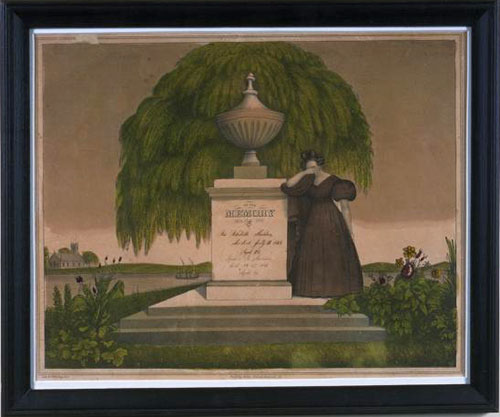Impressions from a Lost World: The Discovery of Dinosaur Footprints
Memento Mori: Death and Loss in 19th Century New England

This memorial is for Mehitable and Sophia Sheldon. Mehitable died in 1824 and was Sophia's mother. Sophia died in 1841. Image courtesy of Pocumtuck Valley Memorial Association/Memorial Hall Museum.
Death and the rituals surrounding loss were a family and community affair in 19th century New England. People usually took their last breaths at home, surrounded by loved ones and neighbors. In rural towns, the sexton tolled the meetinghouse bell to spread the news, beginning with the gender of the deceased (nine strokes for a man, six for a woman, and three for a child) followed by ringing the bell once for each year he or she had lived.
New England was a relatively healthy place to live in this period, particularly in rural areas. Nevertheless, the absence of immunizations, fever-reducing drugs and antibiotics meant that illness claimed many lives, including infants and young children. Farming was the principal occupation for most Americans, and agricultural accidents as well as dangerous conditions in early factories claimed many lives.
Married women could expect to experience at least 5-7 pregnancies, and potential complications during any of these multiple confinements shortened their life expectancy still further. Parenthood all too often included the ordeal of watching one or more of your children die, an experience no less agonizing for its frequency. During an epidemic in the 1830's, a New Hampshire physician mourned the loss of “seven little children, all that he ever had.” Medical treatments were generally ineffective against the viral and bacterial illnesses that could afflict whole communities. Professor Benjamin Silliman of Yale College acknowledged this sad fact in his letter of condolence to Edward and Orra Hitchcock on the tragic loss of their first child, two-year-old Edward, in 1824. Silliman was “very sorry that your anxiety should have been increased by unskilful medical practice, but I have followed to the grave four of my own little flock, whom the skill of the wisest and most devoted physicians could not save.”
The religious culture of the period assigned to every earthly event a divine cause, and death was an ever present specter in the lives of rich and poor alike. The common phrase, memento mori—“remember death”—was meant to remind people of the possibility of their own or another’s imminent demise. When 27-year-old Simeon Dwight of Warren, Massachusetts, died suddenly in 1816, his grieving family acknowledged the hard truths of death and loss on his gravestone:
"Fix’d is the term to all the race on earth
And such is the hard condition of our birth
No force can death resist, no flight can save
All fall alike, the fearful and the brave. "
Until embalming became more common during the Civil War, interment needed to take place quickly. Care of the dead typically fell upon the deceased's family and neighbors. The body was washed, usually by a female member of the household, and wrapped in a shroud- a simple, long sleeved robe open at the back, sewn especially for the purpose. In the case of the poorest residents, a long piece of sheeting known as a “winding sheet” substituted for a shroud. A local carpenter or furniture maker supplied a coffin, typically made of easily-worked pine in the shape of a simple, hexagonal box with a lid. The open coffin was usually placed in the best room, or parlor, before the funeral. The bereaved family customarily covered household mirrors and pictures in white cloth as a symbol of mourning. The home, rather than the meetinghouse, was the focal point where mourners gathered to hear a prayer and perhaps a sermon by the minister. Last came the sad procession to the burying ground, with mourners walking behind the coffin, which was typically carried until towns began keeping hearses to transport coffins to gravesides. Upon arriving at the burying ground, the coffin was lowered into a newly dug grave with little ceremony.
Towns generally did not maintain their burying grounds in the early 1800's; grass and weeds grew up undisturbed, save for the livestock allowed to graze there. This would change as New England communities began taking an interest in beautifying public spaces. Many towns began landscaping their town commons, planting trees, and erecting picket fences. The Mount Auburn Cemetery, established in Cambridge, Massachusetts, in 1831, represented a break with traditional practice. In contrast to neglected burying grounds with weathered stones, Mount Auburn and other new cemeteries became picturesque gathering places for family outings where people took in the sobering influences and natural beauty in the presence of death. Aided by Romantic poets and novelists like Nathaniel Hawthorne and Edgar Allan Poe and by paeans (songs of praise) to nature published by Henry David Thoreau and William Cullen Bryant, the public created a popular culture centered on the sentimentalization or "domestication" of death, as people contemplated monuments set in a place of nature.